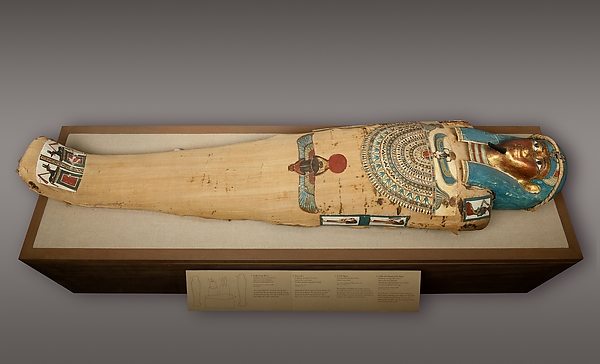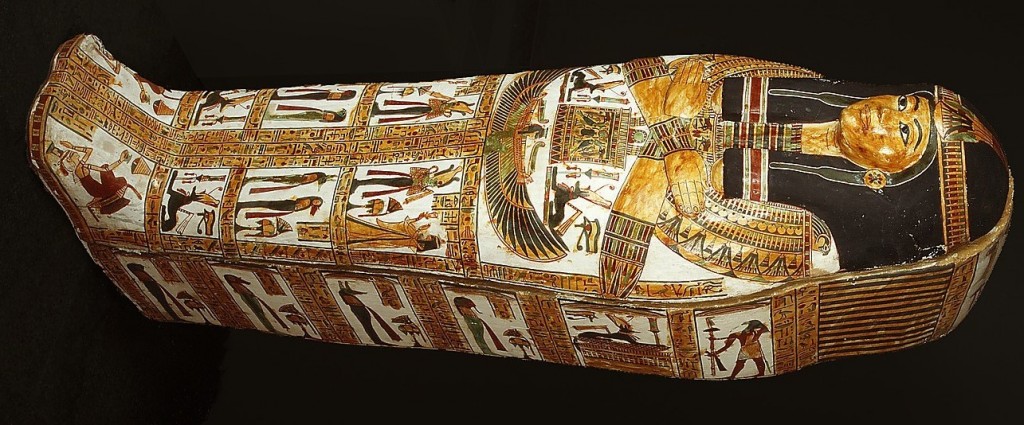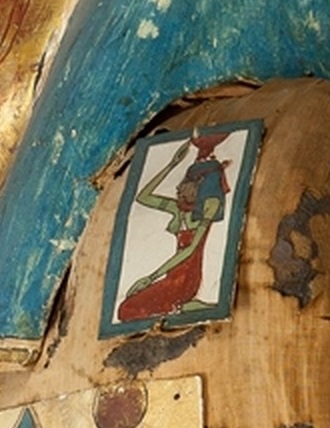Cartonnages in Ancient Egypt were used over the wrapped mummy mainly for mummy masks and some important parts of the body.
The cartonnage of Irtirutja in the Metropolitan Museum of Art of New York dates from the Ptolemaic period. In it one can see how the artist of Ancient Egypt dedicated this technique for covering some special parts of the mummy.

Cartonnages on the mummy of Irtirutja from Ptolemaic Period. Photo: Metropolitan Museum of Art of New York.
The fact of choosing those parts of the anatomy could reveal an intention of including the essential elements in the belief of Ancient Egypt for the dead’s resurrection.
Obviously the mummy mask was obligated, since, among the many faculties the dead had to recover, there were the faculties of seeing and breathing.
The feet of the mummy were covered with two images of Anubis. It seems as if they were inverted, but they are actually dressed to the deceased’s eyesight.
Two images of the scarab with the solar disk were also a grant of the mummy’s rebirth. In Ancient Egypt, the Osiriac resurrection and the solar rebirth were united, in the iconography and in the religious texts.
The four sons of Horus (two at each side of the body) were also included in the composition, They were a personification of the canopic jars, which contained the dead’s viscera, so they accompanied always the deceased.

Coffin of Henettawy with Isis and Nephthys at the feet of the cover. XXI Dynasty. Photo: Metropolitan Museum of Art of New York.

Image of Nephthys mourning in the mummy of Irtirutja. Photo: Metropolitan Museum of Art of New York.
Finally, the ancient Egyptian artist could not omit two of the most important figures in the dead’s resurrection: Isis and Nephthys, the two professional mourners, who making a mourning ritual gave the faculties back to the mummy.
In the cartonnage of Irtirutja these two goddesses are depicted making a typical mourning gesture and are located at both sides of the mask.
In many ancient Egyptian coffins and cartonnages the two professional mourners Isis and Nephthys could be located at the feet of the mummy, in the frontal chest under the image of Nut and also at both sides. Two square pieces of cartonnage with the images of both mourners were located at both shoulders of the dead, next to the two lateral locks of hair of the mask. Was this location gratuitous?
We do not think so, because, according to funerary texts of Ancient Egypt, “the two locks of hair in the funerary mask were Isis and Nephthys” (Coffin Texts 531). And the hair was an element closely related in the thought of Ancient Egypt to the mourners and to the body’s recovery.
Taking into consideration all that, we conclude that:
- The presence of the two mourners Isis and Nephthys in the cartonnage of Irtirutja was a need., omething essential for the mmmy’s resurrection.
- Their location at both sides of the funerary mask was not gratuitous, since it was the place of the two locks of hair, the two mouerners.